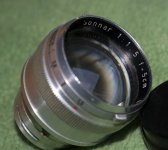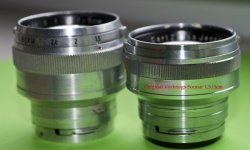S.H.
Picture taker
Hi, I'm unearthing this thread because I just found a strange Sonnar in Contax mount. However, I'm in vacation and I do not have access to the lens itself or to my Contax related books.
This lens is from a German collector who, in the 1970s, checked the focal length because it was bigger than a normal Sonnar. It was found it is close to 60mm, even if it is marked as a 5cm lens. It has also six spanner slots in the rear.
The serial number is 3 14X XXX, consistent with a 1949-1951 build date. It looks like this :

Compared to a regular Sonnar, it is taller :

Could this be one of the 50 postwar real lenses mentioned in this thread?
This lens is from a German collector who, in the 1970s, checked the focal length because it was bigger than a normal Sonnar. It was found it is close to 60mm, even if it is marked as a 5cm lens. It has also six spanner slots in the rear.
The serial number is 3 14X XXX, consistent with a 1949-1951 build date. It looks like this :

Compared to a regular Sonnar, it is taller :

Could this be one of the 50 postwar real lenses mentioned in this thread?
Ernst Dinkla
Well-known
Hi, I'm unearthing this thread because I just found a strange Sonnar in Contax mount. However, I'm in vacation and I do not have access to the lens itself or to my Contax related books.
This lens is from a German collector who, in the 1970s, checked the focal length because it was bigger than a normal Sonnar. It was found it is close to 60mm, even if it is marked as a 5cm lens. It has also six spanner slots in the rear.
The serial number is 3 14X XXX, consistent with a 1949-1951 build date. It looks like this :
View attachment 97063
Compared to a regular Sonnar, it is taller :
View attachment 97064
Could this be one of the 50 postwar real lenses mentioned in this thread?
It will be difficult to get the Sonnars 58-60 mm declared genuine Zeiss. Yet there are good reasons the Sonnars 58-60 mm lenses were designed just before, during and after WW II. The simple fact that the SLRs 35 mm developed in the same period (Dresden, Jena) needed a fast lens and the Sonnar could be that lens but with a slightly longer focal length. In the end the development of coatings in the same period allowed the use of Planar and other double Gaussian types of shorter lengths so the Sonnar design was no longer needed for that purpose. I very much think that the 60mm glass we see in LTM mounts etc was originally intended for SLRs prototypes and not for Contax or Leica RFs. Whoever did mount them in brass or aluminium for RF use is another question. I have a brass LTM version here.
Ernst Dinkla
S.H.
Picture taker
Well, I forgot to post in this section, but mine is from Zeiss Jena :
http://www.rangefinderforum.com/forums/showpost.php?p=2208939&postcount=18
http://www.rangefinderforum.com/forums/showpost.php?p=2208939&postcount=18
Ernst Dinkla
Well-known
A similar story about flak sights accompanied a 6cm 1.5 Sonnar with an odd Meopta mount that was sold through an Austrian camera auction site. It is at the end of my summary of discussions on the "60" mm Sonnars but that link does not work anymore.
http://www.pigment-print.com/Fotografica/CJZ Sonnar 60 f1.5 LTM/target1.html
http://www.novacon.com.br/odditycameras/Opema.htm
I have not seen any reference by Sonnar gurus to early SLR designs in that period for the origins of "6cm" Sonnars but one true Zeiss Sonnar design with a focal length of 57 mm 2.0 is the one discussed here;
http://forum.mflenses.com/viewtopic.php?t=47601
More links to pictures there. A prototype.
A Takumar for SLR based on the Sonnar design is the 58mm 2.0. It simply is impossible to build a 50mm Sonnar for 35mm SLRs.
My bet is that all the Sonnar glass with an odd focal length between 57 and 60 mm were aimed at SLR use. It could be that only the glass was ready when Zeiss decided that the Planar, Biotar lenses were more suited for SLR use. They made a lot of progress with coatings in that period.
Ernst Dinkla
http://www.pigment-print.com/Fotografica/CJZ Sonnar 60 f1.5 LTM/target1.html
http://www.novacon.com.br/odditycameras/Opema.htm
I have not seen any reference by Sonnar gurus to early SLR designs in that period for the origins of "6cm" Sonnars but one true Zeiss Sonnar design with a focal length of 57 mm 2.0 is the one discussed here;
http://forum.mflenses.com/viewtopic.php?t=47601
More links to pictures there. A prototype.
A Takumar for SLR based on the Sonnar design is the 58mm 2.0. It simply is impossible to build a 50mm Sonnar for 35mm SLRs.
My bet is that all the Sonnar glass with an odd focal length between 57 and 60 mm were aimed at SLR use. It could be that only the glass was ready when Zeiss decided that the Planar, Biotar lenses were more suited for SLR use. They made a lot of progress with coatings in that period.
Ernst Dinkla
S.H.
Picture taker
Thank you for the links. Is it the opema lens you speak of :http://www.auction2000.se/auk/w.Object?inC=WLPA&inA=5&inO=229 ?
Also, I found those two :
http://www.auction2000.se/auk/w.Object?inC=WLPA&inA=7&inO=372
http://www.auction2000.se/auk/w.Object?inC=WLPA&inA=1&inO=636
If you want bigger pictures of my lens for your webpage, feel free to ask by PM.
Also, I found those two :
http://www.auction2000.se/auk/w.Object?inC=WLPA&inA=7&inO=372
http://www.auction2000.se/auk/w.Object?inC=WLPA&inA=1&inO=636
If you want bigger pictures of my lens for your webpage, feel free to ask by PM.
Ernst Dinkla
Well-known
That is the one, Opema by Meopta. The text about the origin of the glass is more vague here than in the link I had.
I have checked some WW II bomb sight etc literature on the web and do not see a reference to Sonnar nor diagrams that show a lens assembly with similar Sonnar character. The most common one, the Lotfe 7, a copy of the Norden, has a lens assembly twice the size and it is not a Sonnar. Zeiss made though.
Maybe I should add and renew some parts of that page on the Sonnar 6cm 1.5. When I made it, I was not aware that the odd focal length could have a reason. Since I learned about the Sonnar 57mm lens and the Takumar 58mm for SLR use it became clear to me that SLR use would be a good reason to create a lens of that focal length. Speculation like all the other speculations but for me with more logic. And without a Russian Sonnar design lens of that focal length that can deliver the glass for a Zeiss copy I think the German origin of the glass is plausible. Dresden/Jena to be more specific as the 35mm SLR inventions were happening there.
--
Met vriendelijke groet, Ernst
http://www.pigment-print.com/spectralplots/spectrumviz_1.htm
July 2013, 500+ inkjet media white spectral plots.
I have checked some WW II bomb sight etc literature on the web and do not see a reference to Sonnar nor diagrams that show a lens assembly with similar Sonnar character. The most common one, the Lotfe 7, a copy of the Norden, has a lens assembly twice the size and it is not a Sonnar. Zeiss made though.
Maybe I should add and renew some parts of that page on the Sonnar 6cm 1.5. When I made it, I was not aware that the odd focal length could have a reason. Since I learned about the Sonnar 57mm lens and the Takumar 58mm for SLR use it became clear to me that SLR use would be a good reason to create a lens of that focal length. Speculation like all the other speculations but for me with more logic. And without a Russian Sonnar design lens of that focal length that can deliver the glass for a Zeiss copy I think the German origin of the glass is plausible. Dresden/Jena to be more specific as the 35mm SLR inventions were happening there.
--
Met vriendelijke groet, Ernst
http://www.pigment-print.com/spectralplots/spectrumviz_1.htm
July 2013, 500+ inkjet media white spectral plots.
S.H.
Picture taker
Well, the 58mm does not leave that much space than the regular sonnar to clear the mirror, so I'm not sure it is the reason ...
Share:

